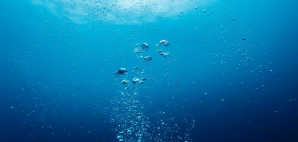Protecting Coral Reefs with Bubbles

Bubbles – yes, bubbles – could help protect coral reefs, oyster farms, and other coastal ecosystems from increasing ocean acidification, according to new research by Stanford scientists.
Blowing tiny bubbles through seawater could help protect coral reefs and oyster farms from oceans turned increasingly acidic through human activities by stripping carbon dioxide (CO2) from coastal marine environments and transferring it to the atmosphere, Stanford scientists say.
Photo credit: Shutterstock
The technique, outlined in a study published online in the journal Environmental Science & Technology, could provide a relatively inexpensive solution to one of the biggest threats facing coral reefs today. An estimated 30 to 60 percent of all the coral reefs have died since the Industrial Revolution as the oceans absorbs more CO2 and become increasingly acidic. Ocean acidification harms a variety of marine organisms, but especially those that use calcium carbonate to assemble their skeletons and shells, such as coral, mussels, and oysters.
"Ocean acidification is particularly troublesome for coral reefs because the entire structure of the ecosystems is built upon the calcium carbonate skeletal remains of dead coral," said lead author David Koweek, a doctoral candidate at Stanford's School of Earth, Energy & Environmental Sciences. "Ocean acidification makes it difficult for corals to calcify and makes it easier to erode these skeletal remains, threatening the integrity of the entire reef."
A further loss of coral reefs would be significant. Worldwide, coral reefs provide an estimated $30 billion net economic benefit each year. A healthy coral reef provides a home to thousands of organisms, which island subsistence communities rely on for the bulk of their diet. A reef's mere presence can quell the waves whipped up by a surging storm, thereby guarding low-lying coastal towns from flooding.
In the new study, Koweek and his coauthors demonstrated that bubbling air through seawater for a few hours in the early morning can enhance the transfer rate of CO2 between the ocean and the air up to 30 times faster than natural processes, resulting in a significant reduction in local marine concentrations of the greenhouse gas.
"The nice thing about the bubble pulse method is that it provides an engineering technique that can help bring us closer to conditions that coral reefs were used to 100 years ago, and to which they've been adapted for many thousands of years," said study coauthor Rob Dunbar, the W.M. Keck Professor of Earth Science at Stanford and Koweek's advisor.
Koweek wondered if it might be possible to spur coral growth by reducing CO2 levels in the water in the predawn hours – when the oceans are most acidic – by using air bubbles to draw the gas out of the seawater and transfer it to the atmosphere. If the bubbles have lower concentrations of CO2 than the surrounding water, the gas will naturally diffuse into the bubbles.
The team set up a bubbling experiment in a sensor-laden water tank at Stanford's Hopkins Marine Station. Each night, they would fill the tank with bags of giant kelp. Throughout the night, the kelp would respire, adding CO2 to the water, and thus acting to simulate the CO2 buildup that occurs from respiration in coastal ecosystems at night. The team would then arrive the following morning, remove the kelp, and begin to bubble the high CO2 seawater in order to test how bubbling lowers the CO2 concentration. They found that just two hours of bubble-mediated ventilation could increase the transfer of CO2 from the ocean into the air by 10 to 30 times.
Koweek thinks bubble stripping could prove useful for protecting small sections of shallow coastline that are ecologically, culturally, or commercially important. Because the operations would be small, the benefits to the marine environments from lowering ocean acidity levels would greatly outweigh the relatively small amount of atmospheric CO2 generated by the bubbling process and by the compressors used to produce the bubbles.
"If this idea takes off, you could imagine people running these compressors on solar power," Koweek said. "In the tropics, where there's a lot of sunlight, you could charge your compressors with solar energy during the day and then bubble at night."
A little bubbling could go a long way, if done strategically. "Many Pacific coral reef terraces have a mostly unidirectional water flow," said Dunbar, who is also a senior fellow at the Stanford Woods Institute for the Environment. "If you operate your bubbler in an area that is upstream of a large section of coral, you could reduce CO2 levels for an entire reef."
Ultimately, bubble stripping could help protect more than just coral. "Many coastal ecosystems, including salt marshes, seagrass meadows, and mangroves undergo daily variations in CO2 due to photosynthesis during daylight hours and respiration during nighttime hours," Koweek said.
David Mucciarone, a science lab manager at Stanford, co-authored the study. Funding for the study was provided by the National Science Foundation and a McGee/Levorsen research grant from the Stanford School of Earth, Energy & Environmental Sciences.
By Ker Than, School of Earth, Energy & Environmental Sciences at Stanford

